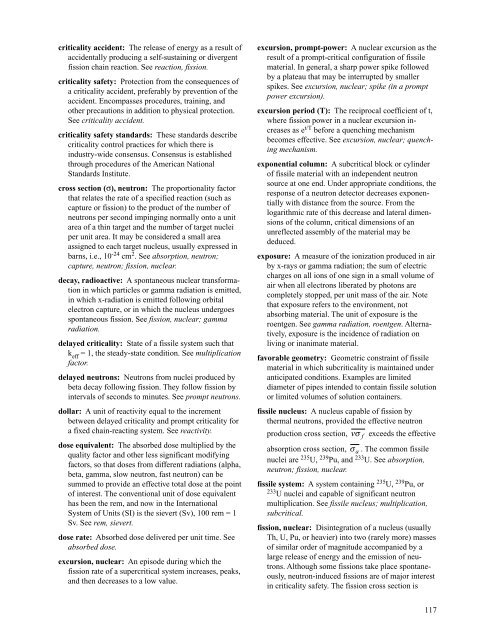A Review of Criticality Accidents A Review of Criticality Accidents
A Review of Criticality Accidents A Review of Criticality Accidents
A Review of Criticality Accidents A Review of Criticality Accidents
You also want an ePaper? Increase the reach of your titles
YUMPU automatically turns print PDFs into web optimized ePapers that Google loves.
criticality accident: The release <strong>of</strong> energy as a result <strong>of</strong><br />
accidentally producing a self-sustaining or divergent<br />
fission chain reaction. See reaction, fission.<br />
criticality safety: Protection from the consequences <strong>of</strong><br />
a criticality accident, preferably by prevention <strong>of</strong> the<br />
accident. Encompasses procedures, training, and<br />
other precautions in addition to physical protection.<br />
See criticality accident.<br />
criticality safety standards: These standards describe<br />
criticality control practices for which there is<br />
industry-wide consensus. Consensus is established<br />
through procedures <strong>of</strong> the American National<br />
Standards Institute.<br />
cross section (σ), neutron: The proportionality factor<br />
that relates the rate <strong>of</strong> a specified reaction (such as<br />
capture or fission) to the product <strong>of</strong> the number <strong>of</strong><br />
neutrons per second impinging normally onto a unit<br />
area <strong>of</strong> a thin target and the number <strong>of</strong> target nuclei<br />
per unit area. It may be considered a small area<br />
assigned to each target nucleus, usually expressed in<br />
barns, i.e., 10-24 cm2 . See absorption, neutron;<br />
capture, neutron; fission, nuclear.<br />
decay, radioactive: A spontaneous nuclear transformation<br />
in which particles or gamma radiation is emitted,<br />
in which x-radiation is emitted following orbital<br />
electron capture, or in which the nucleus undergoes<br />
spontaneous fission. See fission, nuclear; gamma<br />
radiation.<br />
delayed criticality: State <strong>of</strong> a fissile system such that<br />
keff = 1, the steady-state condition. See multiplication<br />
factor.<br />
delayed neutrons: Neutrons from nuclei produced by<br />
beta decay following fission. They follow fission by<br />
intervals <strong>of</strong> seconds to minutes. See prompt neutrons.<br />
dollar: A unit <strong>of</strong> reactivity equal to the increment<br />
between delayed criticality and prompt criticality for<br />
a fixed chain-reacting system. See reactivity.<br />
dose equivalent: The absorbed dose multiplied by the<br />
quality factor and other less significant modifying<br />
factors, so that doses from different radiations (alpha,<br />
beta, gamma, slow neutron, fast neutron) can be<br />
summed to provide an effective total dose at the point<br />
<strong>of</strong> interest. The conventional unit <strong>of</strong> dose equivalent<br />
has been the rem, and now in the International<br />
System <strong>of</strong> Units (SI) is the sievert (Sv), 100 rem = 1<br />
Sv. See rem, sievert.<br />
dose rate: Absorbed dose delivered per unit time. See<br />
absorbed dose.<br />
excursion, nuclear: An episode during which the<br />
fission rate <strong>of</strong> a supercritical system increases, peaks,<br />
and then decreases to a low value.<br />
excursion, prompt-power: A nuclear excursion as the<br />
result <strong>of</strong> a prompt-critical configuration <strong>of</strong> fissile<br />
material. In general, a sharp power spike followed<br />
by a plateau that may be interrupted by smaller<br />
spikes. See excursion, nuclear; spike (in a prompt<br />
power excursion).<br />
excursion period (T): The reciprocal coefficient <strong>of</strong> t,<br />
where fission power in a nuclear excursion increases<br />
as et/T before a quenching mechanism<br />
becomes effective. See excursion, nuclear; quenching<br />
mechanism.<br />
exponential column: A subcritical block or cylinder<br />
<strong>of</strong> fissile material with an independent neutron<br />
source at one end. Under appropriate conditions, the<br />
response <strong>of</strong> a neutron detector decreases exponentially<br />
with distance from the source. From the<br />
logarithmic rate <strong>of</strong> this decrease and lateral dimensions<br />
<strong>of</strong> the column, critical dimensions <strong>of</strong> an<br />
unreflected assembly <strong>of</strong> the material may be<br />
deduced.<br />
exposure: A measure <strong>of</strong> the ionization produced in air<br />
by x-rays or gamma radiation; the sum <strong>of</strong> electric<br />
charges on all ions <strong>of</strong> one sign in a small volume <strong>of</strong><br />
air when all electrons liberated by photons are<br />
completely stopped, per unit mass <strong>of</strong> the air. Note<br />
that exposure refers to the environment, not<br />
absorbing material. The unit <strong>of</strong> exposure is the<br />
roentgen. See gamma radiation, roentgen. Alternatively,<br />
exposure is the incidence <strong>of</strong> radiation on<br />
living or inanimate material.<br />
favorable geometry: Geometric constraint <strong>of</strong> fissile<br />
material in which subcriticality is maintained under<br />
anticipated conditions. Examples are limited<br />
diameter <strong>of</strong> pipes intended to contain fissile solution<br />
or limited volumes <strong>of</strong> solution containers.<br />
fissile nucleus: A nucleus capable <strong>of</strong> fission by<br />
thermal neutrons, provided the effective neutron<br />
production cross section, νσ f exceeds the effective<br />
absorption cross section, σ a . The common fissile<br />
nuclei are 235 U, 239 Pu, and 233 U. See absorption,<br />
neutron; fission, nuclear.<br />
fissile system: A system containing 235 U, 239 Pu, or<br />
233 U nuclei and capable <strong>of</strong> significant neutron<br />
multiplication. See fissile nucleus; multiplication,<br />
subcritical.<br />
fission, nuclear: Disintegration <strong>of</strong> a nucleus (usually<br />
Th, U, Pu, or heavier) into two (rarely more) masses<br />
<strong>of</strong> similar order <strong>of</strong> magnitude accompanied by a<br />
large release <strong>of</strong> energy and the emission <strong>of</strong> neutrons.<br />
Although some fissions take place spontaneously,<br />
neutron-induced fissions are <strong>of</strong> major interest<br />
in criticality safety. The fission cross section is<br />
117

















